WriteMark
Plain Language Standard
Understanding the WriteMark® design guidelines

Follow the WriteMark design guidelines to create clear, welcoming documents that your readers will love. Image by Sarah Pflug / Shopify licence
One of the criteria we use to evaluate documents is actually a bundle of requirements in one question: ‘Does the document meet the WriteMark® design guidelines?’
What are the design guidelines? Why are they important? And how can a document meet them? Today’s blog walks you through the design guidelines and explains why they’re part of the WriteMark® Plain Language Standard. Click the link below to see the design guidelines for yourself.
Download the WriteMark® design guidelines
The design guidelines ensure a document looks clean, clear, and accessible
The WriteMark® design guidelines cover four main areas, which we’ll explore in detail below.
- Text and headings
- Spacing and margins
- Graphics and colour
- Navigation
The guidelines ensure documents are inviting and easily legible. They favour simplicity over complexity, and support a clean, open, and accessible reading experience (without compromising brand look and feel).
Like the text and ‘big picture’ elements of the WriteMark®, the design guidelines prioritise the reader. They create a reading experience that aids navigation and understanding. Most importantly, they make documents work for the widest possible audience, by ensuring vision-impaired readers can access and use them.
However, the WriteMark® design guidelines are not a comprehensive resource for creating accessible documents.
Check out our blog posts on accessibility for more tips
Text and headings — ensure fonts are legible and headings aid navigation
The text elements of the WriteMark® design guidelines are mostly satisfied by choosing an easy-to-read typeface and a clearly legible font size. ‘Easy-to-read’ is slightly subjective, but as long as it’s not too light, narrow, or heavy — and you minimise bold, italics, and capitals — it should meet the standard.
The actual size of text, and how easy it is to read, depends on the typeface you choose. We usually recommend a 10-point minimum font size, but some typefaces may need to be bigger or smaller.
Headings help readers skim-read to find the information they need. To do this, they need to be formatted in a clear hierarchy (for example, top-level headings are the biggest, then second-level headings, and so on). Font size, weight, and colour can all work to distinguish different heading levels. Italics and underlining can work too, if needed.
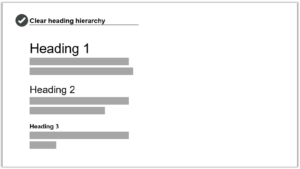
Use a clear heading hierarchy to show the relationship between different sections and subsections in text. Image by Write Limited
The spacing above and below headings should put them closer to the paragraph they introduce, rather than ‘floating’ equally between the text before and after.
Finally, avoid ALL-CAPS and Title Case in headings — sentence case is easier on the eyes.
Spacing and margins — use white space to create an inviting layout
As readers, our eyes are drawn towards a roomy layout with plenty of white space (meaning parts of the page with nothing on them). On the other hand, a dense ‘wall of text’ looks and feels like a struggle to read. These can drive readers away.
To achieve a spacious layout:
- use generous margins and spacing to create white space around your text
- use ample and consistent spacing between lines and paragraphs.
A 2.5cm or more margin is good for printed documents. Microsoft Word uses 2.54cm margins (or 1 inch) by default.
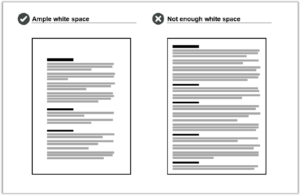
Wide margins and generous spacing create ample white space. A page without enough white space looks cluttered and feels like a chore to read. Image by Write Limited
Comfy margins, spacing, and font size should also create a readable line length. Line length is the number of words or characters on each line of text. We recommend aiming for 45–75 characters per line for printed text. Longer line length can look and feel like a chore to read.
Use spacing to show the relationship between different elements on the page
You can also use spacing to support navigation. Readers automatically recognise a kind of ‘layout language’ created by grouping and aligning certain elements. Use spacing to reinforce elements that are connected, and create breaks between elements you want to separate.
More specifically, our design guidelines recommend you:
- use line spacing to visually group bullet lists with the text that introduces them
- align images with margins, and place them close to relevant text and explanations.
Graphics and colour — choose images that support text and use contrasting colours
If your document includes graphics, make sure they clearly support or clarify the text. Graphics that are only tangentially related to the text can throw readers off-course. Check that graphics have the necessary captions, titles, or labels as appropriate.
Graphics need to be easily legible without zooming or squinting. Consider the different ways readers will encounter your graphics (for example, printed or online), and make sure they are large and clear enough across all of the options.
To accommodate visually impaired readers, make sure graphics have either:
- alt text — short descriptions for simple photos and illustrations
- long descriptions — detailed explanations of complex elements, like graphs.
Check that the colours you use have a strong enough contrast to be easily legible. If colours are too similar, some elements become difficult to read — especially for colour-blind readers. Use a tool like Colour Contrast Analyser to check your colours, and be aware that smaller fonts need higher contrast.
Download Colour Contrast Analyser
Navigation — create well-defined sections and include a table of contents
Finally, use design to help readers navigate through your document.
We’ve mentioned already how heading hierarchy and spacing can help readers understand the relationship between sections and subsections in a document. Here are some more tips to improve navigation.
- Make each new section obvious (consider a page break if space allows).
- Include a table of contents for documents longer than two or three pages.
- Make sure the table of contents has ‘leader lines’ between the section heading and page number.
- Check that all links in digital documents work, including in the table of contents.
Trust your gut
Our final tip is not written in the design guidelines: trust your gut!
Implementing great design takes skill and experience. But recognising good design is something anyone can do.
Put yourself in your reader’s shoes. Take a step back and look at your document — does anything look unbalanced, or busy? Is your eye drawn where it needs to go? Does the density of text feel light and digestible, or does just looking at it make you want to close the window and take a coffee break?
Your own reaction is instructive, because it may indicate how other readers will respond to your document’s layout.
Follow the design guidelines — and trust your gut!
Download the WriteMark® design guidelines
Ryan Tippet July 9th, 2024
Posted In: The WriteMark
Tags: accessibility, clear communication, clear thinking, clear writing, design, design guidelines, guidelines, plain language, Quality writing, the WriteMark, WriteMark
Why the WriteMark® matters more than ever in the age of AI writing

Photo by cottonbro studio / Pexels licence
One of our favourite plain language mottos adorns the wall in massive text at Write’s Wellington office. It’s from Sir Ernest Gowers’ book, Plain Words: ‘Be short, be simple, be human’.
It’s a motto that follows its own advice.
In the burgeoning age of ‘AI’ text generation, human writing for human readers is more important than ever. And that makes the WriteMark® an even more valuable symbol of people-centric plainness.
Here’s why a quality mark for clear communication matters even more in the age of AI.
People-centric writing stands out in an AI-generated torrent
The WriteMark® has always been a way to show your readers you care.
The heart-shaped symbol demonstrates your commitment to being clear, open, and customer-focused. It signals to your audience that you’ve gone the extra mile to ensure they understand what you’re telling them, which builds trust and confidence.
We think readers will particularly appreciate the WriteMark’s® quality promise as AI writing proliferates. AI-generated text risks ‘infecting’ AI training data — the library of information that AI tools use to create their responses. This may degrade the quality of AI outputs over time, as they reinforce and amplify their own distortions and biases. Commentators have called this an ‘AI ouroboros’
Read about the ouroboros on Medium’s website
In this uncertain future of AI writing, the WriteMark® will signify people-centric writing that gives readers confidence and helps to form human connections between author and audience.
Our human assessors give human insights
In a WriteMark® assessment, qualified experts read documents, assess them against 25 carefully selected criteria, and produce a report packed with insights and recommendations. They apply a critical eye, drawing on their experience and understanding — as both writers and readers — to identify what works and what needs work. This experience and insight helps to shape documents that serve their writers — and their readers.
AI can do some incredible things, if you know how best to use it. By drawing from untold libraries of human writing and thought, it can generate convincing text and images in the blink of an eye. It can educate and entertain, adapting its tone and language for any conceivable audience. But AI is not critical, creative, or insightful — not yet.
Big-picture elements require critical thought
AI can provide lots of helpful advice for some of the more mechanical aspects of plain language, like sentence structure and word choice. But humans can still do a few things better — like thinking.
‘Artificial intelligence’ is a bit of a misnomer, because tools like ChatGPT and DALL·E 3 are not thinking or creating. They draw on vast sets of training data from the web and use predictive patterns to spit out realistic answers to prompts.
This means AI would struggle to meet or assess some WriteMark® criteria, especially big-picture elements. It takes critical thought to determine whether a document has:
- a clear purpose
- an overall structure that helps readers to understand it
- answers to all the questions a reader is likely to ask.
AI is improving constantly, and quickly. But answering these questions requires critical analysis and holding the ‘big picture’ in mind — skills that today’s AI tools can only imitate.
AI can be a cultural liability
Our assessors have another advantage over AI tools — their Kiwi cultural context and sensitivity.
AI tools draw on training data from all corners of the internet. This means they tend to replicate and reinforce existing biases in that data. Aotearoa New Zealand represents a tiny corner of the internet, so our cultural differences are easily overwhelmed by American and European norms in AI’s predictive patterns.
Why does this matter? One element we assess for the WriteMark® is whether the document has an appropriate style and tone for its audience. Aotearoa’s cultural context is different from the rest of the world in lots of small ways — as well as the big ones, like the role of te reo and te ao Māori. The words we use and the way we express ourselves are distinct, as are our history, economy, politics, and culture.
AI tools are liable to get these small things wrong, because they draw from the wilderness of the World Wide Web. As well as setting the wrong ‘style and tone’ for our specific cultural context, relying on AI can lead to embarrassing and even offensive errors.
The WriteMark® Plus gives unrivalled insight into how readers experience a document
On top of using human experts to assess documents for the WriteMark, we get human non-experts to test how well a document serves its readers for the WriteMark® Plus.
User-testing with real readers always uncovers unforeseen sticking points. Human testers can help identify things like:
- whether a certain word choice or section is confusing
- whether a document’s structure matches readers’ expectations
- whether a document is accessible to readers of all abilities
- whether a document is practical to use in the real world.
AI is clever, and convincing. But there’s simply no substitute for testing a document with its target audience.
AI can be a powerful plain language tool — learn how to use it safely
While human expertise can’t be beaten when it comes to the high standard of the WriteMark, we still recognise the value of this powerful tool.
That’s why Write has added an Write smarter with AI workshop to our roster, and why we’re keeping up to date with advances in the field.
Check out our workshop, Write smarter with AI
Read our blog post about how to get the most from AI
Ryan Tippet February 12th, 2024
Posted In: Plain English, Plain language, Plain Language Awards, The WriteMark, WriteMark Plus
Tags: AI, AI Writing, clear communication, clear language, clear thinking, clear writing, plain language, power of plain language, Quality writing, the WriteMark, WriteMark, WriteMark Plus
How does the WriteMark® compare to a new international standard?

We’ve mapped out how the WriteMark sits next to the new ISO Standard. We wanted to be sure our mark of plain language quality aligns with international best practice. And we wanted to understand where and why the two standards differ | Photo by Alexander Suhorucov on www.pexels.com
In June 2023, the International Organization for Standardization, or ISO, released Part 1 of its first-ever Plain Language Standard. The ISO Standard offers guidelines for writing in plain language, arranged around four organising principles. These establish that information should be relevant, findable, understandable, and usable.
Read our blog about the ISO Standard over on the Write website
How does the WriteMark® Plain Language Standard, developed here in Aotearoa New Zealand, compare to the new international standard? Do the two standards have any disagreements?
If your document holds the WriteMark®, does it also meet the criteria in the ISO Standard?
Is the WriteMark® keeping pace with international best practice?
Let’s answer those questions one by one.
Comparing the WriteMark® to the ISO Standard
As we pointed out in our blog post on the Write website, the ISO Standard doesn’t include quantitative measures. It doesn’t give users a way to certify documents that ‘meet the standard’.
So, right off the bat, the ISO Standard does something quite different from the WriteMark®.
The WriteMark® logo shows that we have assessed a document and we recognise its excellence in clarity and presentation. The WriteMark® uses 25 criteria to evaluate whether or not a document or website meets a high standard of plain language.
But although they have different purposes, the guidelines in the ISO Standard broadly align to the criteria in the WriteMark®.
Here’s an example.
- Guideline 5.2.4(a) in the ISO Standard says to ‘Use a new heading when introducing a new topic’.
- To achieve the WriteMark®, a document must have ‘useful, informative headings to guide the reader’.
The ISO guideline is more specific, but the WriteMark® requirement captures the same intent.
Many of the ISO Standard guidelines go into more detail than the WriteMark® criteria. The WriteMark® simply asks if a document’s structure is ‘clear and logical to the reader’. The ISO Standard, in comparison, recommends:
- placing the most important information first
- separating supplementary information
- presenting instructions in chronological order
- and several more specific guidelines.
These guidelines are all part of a ‘clear and logical’ structure. The guidance in the ISO Standard and requirements of the WriteMark® aren’t at odds — they’re doing different things, at different levels of detail.
The ISO Standard emphasises a different purpose
The ISO Standard and the WriteMark® do, however, place emphasis in different areas. These differences are worth exploring.
The first area is the document’s ‘purpose’. For the WriteMark®, a document needs to have a clear purpose, and its content needs to support that purpose.
Makes sense, right? We know that documents are most effective when they’re written with a clear goal in mind.
The ISO Standard, however, strongly emphasises the purpose of the reader. Writers should identify their reader’s purpose for reading their document, and put their readers’ needs first.
This also makes a lot of sense! Clear plain language documents put their readers first.
So which perspective is correct? Successful documents will fulfil both their readers’ and writers’ purposes. They’ll achieve what their author needs them to, while being entirely transparent and practical for readers to use.
The question is whose purpose is front of mind, and when. And that will depend on your document, your audience, and, of course, your own purpose for writing.
We explore this question further in another blog on the Write website:
Comparing the ISO Standard to the Plain Language Act and Write Plain Language Standard
The ISO Standard brings elements together under an umbrella of ‘cohesive’ writing
Another distinction between the ISO Standard and the WriteMark® is in the idea that documents are ‘cohesive’.
The third principle of the ISO Standard, ‘understandable’, covers what we often think of as ‘language elements’. This means using familiar words, short and active sentences, concise paragraphs, and a reader-friendly tone.
The ISO Standard then collects these elements, along with the structure and headings from the principle of ‘findable’, under an overall direction to ‘Ensure that the document is cohesive’.
This means, in short, make sure all the parts of the document work together. They have clear and consistent relationships. They all serve a common purpose.
Unlike the ISO Standard, the WriteMark® doesn’t have any one particular requirement for documents to be cohesive.
We’re already looking at how the elements of a document cohere throughout the WriteMark® process. In a WriteMark® assessment, we are checking that the words have a cohesive tone, that the structure presents a cohesive whole, and that the presentation elements are consistent and appropriate.
The guidance to write cohesive documents is handy, but as a requirement in the WriteMark® it would only duplicate other elements we’re already assessing.
Does a WriteMark® document meet the ISO Standard?
A document can’t ‘meet the ISO Standard’, because the ISO Standard is a set of guidelines, not requirements. But let’s put that technicality aside and rephrase the question in a way that we can answer:
Does a WriteMark® document have the same quality of plain language as a document developed using the ISO Standard guidance?
To that we can confidently say, ‘yes’. Documents that achieve the WriteMark® will also satisfy the ISO Standard’s organising principles. WriteMark® documents are all different, but each one is:
- purposeful and reader-focused to ensure information is relevant
- organised and structured to make information easy to find
- welcoming and clearly written to make information easy to understand
- practical and concise to make information easy to use.
And this relationship goes both ways. If you follow the guidelines in the ISO Standard, you’ll develop a document that’s well on its way to meeting the WriteMark®.
Again, we can find some differences in the details, but the two standards are well aligned overall.
For example, to achieve the WriteMark®, a document must use mostly positive sentences. The ISO Standard doesn’t mention positive or negative sentences — possibly because it applies across languages, not just English. But its instructions to write concise sentences with a clear structure will ensure they are also mostly positive.
Updating the WriteMark® to keep pace with international best practice
We want to be certain that the WriteMark® reflects the best practice in plain language, which means updating it from time to time. The ISO Standard finally arriving after years in the making has been a good prompt for us to make some tweaks.
Following the emphasis in the ISO Standard, we’ve added a cue to the WriteMark® assessment to note a document’s purpose and audience. This gets us and our clients thinking about the ISO Standard principle of ‘relevant’.
It’s a reminder to consider:
- who you’re writing for
- your readers’ context when encountering your document
- what you and your readers hope to achieve with this document.
We’ve also added a reminder to the assessment about making documents cohesive. This notes that a document is cohesive if its language, presentation, and big picture elements all support its purpose and the purposes of its readers.
And we took this opportunity to align the wording in some of the WriteMark® criteria more closely with Write’s Plain Language Standard, just to keep things tidy.
More resources
Download Write’s Plain Language Standard for free
Learn about the WriteMark® criteria and assessors
Buy a copy of the ISO Plain Language Standard
Ryan Tippet July 3rd, 2023
Posted In: Plain language, The WriteMark
Tags: clear communication, guidelines, industry standards, International Organization for Standardization, ISO, ISO Standard, plain language, Quality writing, the WriteMark
Start as you mean to go on — with clarity

Verity White of Checklist Legal believes plain language builds trust in client relationships | Photo courtesy of Checklist Legal
For a small-to-medium business, working with people who have similar values and goals is really important. Building a lasting and valuable client relationship relies on trust, and from the client’s perspective, that relationship starts at the point of engagement. So Verity White of Checklist Legal decided she wanted really clear documents to start off the client relationship.
She drafted the documents herself but decided to get some external help from Write and WriteMark®. That way she could be doubly sure the client would know what they were signing up to and the relationship would start off on the right foot.
Checklist Legal makes legal advice clear
Verity’s company is all about taking the stress and confusion away from legal situations. One of the main ways she achieves that is through her clear, easy-to-understand advice. She creates readable documents that help her clients achieve their business goals.
Contracts are a core part of a business and reflect the way a business builds a client relationship. Verity is passionate about the ways that clear contracts support client connection and engagement, representing an authentic brand voice, so that the contracts feel like something that belongs to the business. That’s why achieving the WriteMark felt so important to Verity and Checklist Legal.
Verity tells her story below.
Using the ‘Rewrite’ principles to achieve clarity and develop trust
I first came across Write when I attended the plain language conference in Wellington, New Zealand in 2016. I absolutely fell in love with Write as a plain language organisation and with their Rewrite for Change programme. I knew I wanted to be involved with them in some way, shape, or form! And it took launching my own boutique law firm to make that opportunity come about.

Verity White of Checklist Legal was inspired by plain language principles to apply them to her own business | Photo courtesy of Checklist Legal
I thought my engagement documents were pretty good. I had met a bunch of the readability criteria that I had set for myself in creating them, as well worked on the information design. And then I got some really helpful feedback from the Write team, and they helped me refine things a little bit further.
Getting an independent peer review
Camilla Anderson, one of my other plain language and visual contracting heroes. always says that if you had two people speaking French and you wanted to simplify French into a different language, you wouldn’t get French people who only speak French to simplify that language.
So when it comes to simplifying legal writing, having someone else take a look at your own legal writing is often a great approach. It gives you a fresh eye, and it is that trained professional view that I really appreciated from having Write go through the documents. Of course, the ultimate decision on the legal bits and pieces of the documents sits with me. But I really appreciated the advice and patience of the Write team, as we worked through the finer points of the wording together.
Walking the talk by achieving the WriteMark® and other certification
I wanted to be able to show that I was walking the walk and talking the talk when it comes to plain language, which I think is really important for law firms. A lot of law firms claim to be writing in plain language, but they really don’t go to the effort of getting their documents checked out fully. And I think that’s shown by the fact that Checklist Legal is the first law firm in Australia to have certified its plain language engagement documents with Write.
In very exciting news, Checklist Legal has recently become a certified B Corp! And I’ve published my new book called Create Contracts Clients Love — the title says it all really!
Check out Verity’s book called Create Contracts Clients Love
Find out about Checklist Legal’s B Corp impact
Find out about Checklist Legal’s pro bono programme
Anne-Marie Chisnall June 9th, 2022
Posted In: WriteMark Holders
Tags: accessibility, Australia, Checklist Legal, client engagement, client relationship, consultancy, law firm, legal agreement, Legal documents, legal writing, plain language, the WriteMark, trust
Using words for good — an experiment in the power of care

Lynda Harris conducts an experiment in the power of care through plain language. Image by DaMoJo / Excio licence
This B Corp month (March 2022), Lynda Harris explores links between being a B Corp and using words for good. Write, the company behind the WriteMark® and WriteMark® Plus, became a B Corp in 2021.
This blog was written for accredited and aspiring B Corps. But the ideas are relevant to all business writers!
Does being a B Corp improve the way you write? It certainly does for some B Corps.
A few years ago, I did a small experiment with some B Corps to see if their focus on being a force for good in the world influenced the way they wrote. And it did! I don’t know if all B Corps write clearly. But I do know that being a B Corp will give you a great head start.
Find out more about B Corps in Australia and New Zealand on the B Corp website
What made me do that experiment?
As a plain language professional for over 30 years, with a passion for training people in the art of clear communication, I’d seen some people transform their writing overnight simply by being encouraged to apply the age-old ‘golden rule’. Asking a writer to treat their client as they would like to be treated and ‘walk a mile in their shoes’ sometimes trumped more formal writing techniques. And almost instantly writers produced much clearer, more reader-friendly documents.
Since the notion of honouring ‘people and place’ is baked into B Corps, I wondered if the foundational concepts of care and empathy would naturally translate into a more effective, human-centred writing style from those firms.
Testing my idea
So I decided to find out if my hunch was right and interviewed several B Corps. To raise the bar, I picked a sector traditionally known more for obfuscation than clarity — law firms!
Here are some of the inspiring responses to my all-important question, ‘Do your B Corp values, especially your value of care, influence the way you write to clients?’
From Alexandra Doig, Managing Partner of Atticus Lawyers in Melbourne:
Yes! Telling people what they need to know and doing all we can to help, means we need to write like a human. We need to communicate clearly and personally in ways that don’t alienate. We can’t give a client a convoluted document. We have to walk the talk and act on what we believe in.
We could write a 10-page document. We try to write a 1-pager that clearly captures the most important info and that the client can easily understand and be comfortable with. It’s a calculated risk — with benefits. We want to write in a way that gives clients that lightbulb moment If a client doesn’t walk away with a greater understanding of their position than they had when they arrived, we haven’t done our job properly.
From Joel Cranshaw of Clearpoint, Australia
Yes! I say that for two reasons. Our retainer-based fee model means that we must work efficiently — so we must be clear, concise, and to the point. And what we believe in, our philosophical approach to compassionately meeting clients’ needs, also means that we must communicate in ways they can readily understand.
From Sophie Tremblay of Novalex, Canada:
Absolutely! We know that even the smartest people aren’t necessarily familiar with legal terms and concepts. So a huge part of what we do is to make the law understandable. We use concrete examples and remove the abstract, along with many other techniques such as metaphor (it’s like), and ‘this means’… We remove jargon and make important concepts stand out. We do what we need to do to be understood.
Accidentally using plain language techniques
Hearing Sophie’s list of useful plain language techniques, I asked if she had ever had any formal plain language training. She hadn’t. Nor had Alexandra, or Joel. Yet instinctively, motivated by strong human values and a sense of care, all three ticked so many plain language boxes.
Here’s what a sense of care, and a desire to connect and be helpful, prompted these firms to do:
| Keep the content as concise and relevant as can be — thinking very carefully about what the client needs and sticking to that, avoiding cognitive overload | ✅ |
| Use a layout that is carefully organised and makes important points stand out | ✅ |
| Make it personal, putting yourself in your reader’s shoes, being ‘compassionately reader-centred | ✅ |
| Focus on clarity, explaining concepts in a way non-lawyers could understand | ✅ |
| Use metaphor or simile (it’s like) and reader-friendly interpretations (this means) | ✅ |
| Avoid jargon | ✅ |
Without knowing it, they applied these key principles of plain language:
- a highly personalised approach aimed at connecting and truly helping
- clear organisation of content focused on achieving a specific purpose
- clear, familiar language and a major attempt to explain unfamiliar concepts
- a layout that signals key messages and supports comprehension.
And while achieving the above, they naturally applied more detailed concepts of plain language, such as writing in the active voice, favouring verbs instead of nouns, writing strong informative headings, and so on.
Since doing those interviews, I have informally looked at the websites of many other B Corps. My sense has been that a good number show a higher standard of clarity and connection than their non-B Corp competitors. And some are outstandingly clear and inviting.
So what do the results of my experiment mean for you?
First it means that your B Corp values are most likely influencing you to write with more care. That’s great! But rather than assuming, why not test your writing against a recognised plain language standard? You can download the Write Plain Language Standard here for free and use it as you wish in your organisation. Quite apart from putting your writing to the test, using the Standard will help you label some of the good practices you may already have and teach you some you weren’t aware of.
For some, perhaps those creating and retailing products, the focus on plain language may be easier.
But for others, working in industries known for complex concepts and language, it will be a bigger challenge. However, if lawyers can do it, you can too, right? (Shout out to Sharesies, the Cooperative Bank, Pathfinder, KiwiBank, and others who prove you can write warmly and clearly in the financial sector too!)
What’s the deal with plain language anyway?
It’s probably pretty clear to you by now that striving to create clear, human-centred writing has many practical benefits.
When you focus on the purpose of an email, you’re more likely to get understanding and the action you’d hoped for. When you focus on what the user needs to know, and begin with action words in a set of instructions, your user is more likely to follow them. When you put just the right content in a report, and use informative headings, your reader is more likely to keep reading. When you write your terms and conditions with a reader-friendly tone, using everyday words and making key messages clear, people are more likely to feel positive about them.
And at the big-picture level, plain language is essential to a functioning democracy in which all people can access their rights and understand their obligations. Human-centred writing makes everything work better.
But here’s the most important bit for you
Actively applying the ethos and principles of plain language creates a beautiful congruence between your values and how you show up in the world. It’s about authenticity and speaking in a voice that truly reflects who you are. It’s really at the heart of being a B.
- Find out more about B Corps in Australia and New Zealand on the B Corp website
- Download the Write Plain Language Standard
- Read about the benefits of plain language
- If you’re in New Zealand, support the Plain Language Bill by making a submission
- Ask us about getting the WriteMark® on your documents
Lynda Harris March 22nd, 2022
Posted In: Plain language, The WriteMark, WriteMark Plus
Tags: b corp, human-centred language, plain language, using words for good, WriteMark
Kimble Center’s healthcare form awarded ClearMark

The Kimble Center's Power of Attorney for healthcare goes to new heights | Photo by Brands&People on Unsplash
Could the Kimble Center for Legal Drafting’s Power of Attorney for healthcare win any more accolades? Turns out the answer is a definite ‘yes’.
The ClearMark Awards judged the healthcare form worthy of the award for best legal document. The ClearMarks are organised by the US Center for Plain Language and recognise the best plain language communications created by organisations in North America. The Center’s Barbra Kingsley and Alex Miranda announced the 2021 winners as part of the Access for All virtual conference in May.
The judges said about the power of attorney that:
[it] is a wonderful example of making legal text accessible.
And they went on to say:
The writers conducted several different kinds of user testing, including with health professionals and typical lay users. They also benefited from input from the Center’s international board members and PL (plain language) experts in New Zealand. The effort shines through. It’s an exemplary piece, worthy of being winner in its category.
View the list of ClearMark winners
Read about the ClearMark award in an article by Oakland County Legal News
Taking legal documents to new heights
The Kimble Center for Legal Drafting paves the way for innovative, accessible legal documents. This article on the Center’s website describes its origins and goals.
People can use the Power of Attorney document to set up a person they trust to make decisions about their healthcare if they’re not able to. The Power of Attorney is easy to understand and fill out — and it’s free to use for US citizens.
More than 1000 people have used the form since it was published.
Find out more about WriteMark® Plus — the ultimate in communication excellence
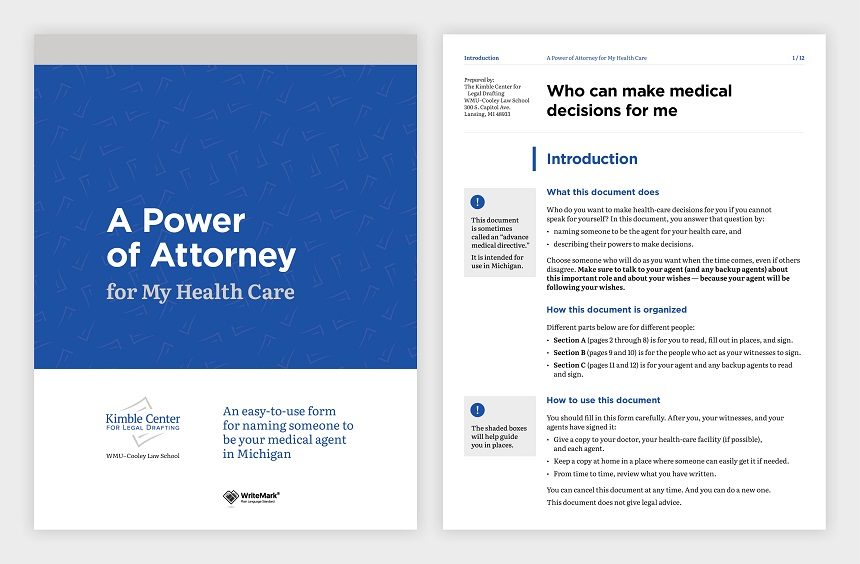
Design elements guide the user through the document. Image by Gusto Design.
Anne-Marie Chisnall May 21st, 2021
Posted In: The WriteMark, WriteMark Holders, WriteMark Plus
Tags: accessibility, ClearMark, Joseph Kimble, Kimble Center for Legal Drafting, Legal documents, plain language, WriteMark, WriteMark Plus
Reaching a plain language standard helps you reach your audience

Aim high — achieving a plain language standard will help your document work for your readers
An international colleague asked us about our two plain language standards:
Is the Write Plain Language Standard the same as the criteria for assessing a document and giving it the WriteMark®? Or are the Standard and the WriteMark® two different and separate tools?
Here’s how the two Standards came to be, how they relate to each other, and how they’re different.
The Write Plain Language Standard is available for all to use
The 10 elements in the Write Plain Language Standard are a highly condensed version of the 28 elements in the WriteMark® Plain Language Standard.
The WriteMark® came first, and only documents assessed by our approved assessors can carry it. Several years later, because our clients wanted a standard they could apply themselves, we created a shortened form.
This shorter, easy-to-use standard became Write’s Short Plain English Standard. We’d customise it specially to suit our clients’ specific needs. And clients would often include their standard in their style guide.
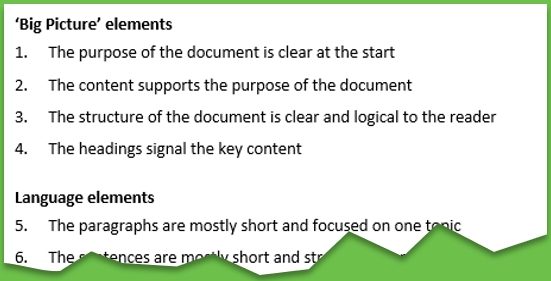
Aim high — achieving a plain language standard will help your document work for your readers. Image by Write Group Limited
Eventually we made the short form (now called the Write Plain Language Standard) freely available under a Creative Commons licence. Anyone can use it to check and improve the quality of their writing.
We often use the Write Plain Language Standard as an audit tool. Our clients want to understand how their writing measures up against widely accepted plain language criteria.
Download the Plain Language Standard at the Write website
The WriteMark® is a mark of document quality available by assessment
We use the WriteMark® criteria when an organisation wants to show that their document has been independently assessed as meeting a very high standard of plain language. Achieving the WriteMark® gives them the right to display the WriteMark® logo — seen as a quality mark — on their document.
WriteMark® Plus is another option we’ve recently developed. It combines the WriteMark’s® elements-based assessment with document user-testing. We or another approved testing agency will test the document with readers who match the profile of the target reader.
Many clients now prefer to achieve the WriteMark® Plus, which demonstrates an even greater commitment to plain language.
Read about an insurance policy that achieved the WriteMark® Plus
Read about a legal document that achieved the WriteMark® Plus
Get in touch if you’d like to know more about the WriteMark®
Lynda Harris November 10th, 2020
Posted In: The WriteMark
Tags: industry standards, plain language, the WriteMark, Write
A plain language love story

Image by Andre Furtado / Pexels licence
We’re head-over-heels for plain language, and we’re always excited when we find others who share our passion. Take Southern Cross Travel Insurance (SCTI): we’ve just awarded the WriteMark® to their new domestic travel policy.
SCTI decided the time was right to offer an insurance policy that would help New Zealanders feel safe and secure when travelling around New Zealand. The WriteMark® shows that SCTI is dedicated to bringing their customers a policy that’s clear and easy to understand.
Nick Bassett, Acting Head of Sales, Product and Marketing, says they wrote the policy with their customers in mind:
We’re committed to providing our customers with excellent service, and knowing what they’re covered for when they buy their policy is incredibly important. The WriteMark® stamp is an endorsement of transparency and integrity, which is why we’re so pleased to have launched our first policy document in plain language, and to have achieved this recognition.
To celebrate, we’ve created a video that showcases everything there is to love about an insurance policy with the WriteMark®.
Your customers deserve a policy that understands them
Insurance should give us peace of mind because we know we have support in times of stress and uncertainty. A policy written with everyday words, short sentences, and useful headings locks in that peace of mind, because you know exactly what you’re covered for.
By writing your insurance policy in plain language, you’re showing that you care about your customers and can think from their perspective. Your transparency will help build their trust.
Learn more about writing insurance policies in plain language
Want to start your own plain language love story? Ask yourself what your reader needs from you, and make sure you deliver it in a way that’s easy to understand.
Insurance cover is complicated, and your readers will thank you for finding a way to lead them through it, without all the jargon. You’ll find lots of helpful tips in our easy-to-use checklist — the Write Plain Language Standard.
Download Write’s free Plain Language Standard
Take our Plain Language Foundations online course
Read our recent blog post on how plain language can help institutions win back trust
Find out more about getting a WriteMark® assessment
Anne-Marie Chisnall September 14th, 2020
Posted In: The WriteMark, WriteMark Holders
Tags: Insurance writing, plain language, policy writing, WriteMark
Kimble Center’s Power of Attorney goes to the top of its class

Organising a power of attorney document for your healthcare means others can take care of you when you can’t. Image by Bimatshu Pyakuryal / Unsplash licence
We all hope we’ll always be able to make our own decisions about our healthcare. But what if we can’t?
The Kimble Center for Legal Drafting, based at Western Michigan University–Cooley Law School in the US, has published a new Power of Attorney document. People can use the Power of Attorney to set up someone they trust to make decisions about their healthcare if they’re not able to. What’s more, the Power of Attorney is easy to understand — and it’s free to use for US citizens.

Design elements guide the user through the document. Image by Gusto Design.
The Kimble Center’s legal team decided they wanted their new document to be top of its class. So they first asked the members of their advisory board for feedback. Then they applied for another layer of review through the WriteMark assessment process.
The WriteMark® assessment considers purpose, structure, content, language, and design as part of a rigorous document analysis.
Design to support the purpose of the document
The Center engaged the team at Gusto Design to create a design that would support clarity and readability.
Annette Ellis, Creative Director at Gusto, explains:
We worked with the Kimble Center for Legal Drafting to make a complex process clear and easy to understand. The plain language used for the Power of Attorney form is visually supported using design elements that guide the user through the form, making it easy for them to understand and fill out.
Instructions are provided as shaded boxes adjacent to the form fields, providing users with additional information that helps them understand how to fill out the form correctly. This extra guidance is critical to ensure the form accurately captures their wishes.
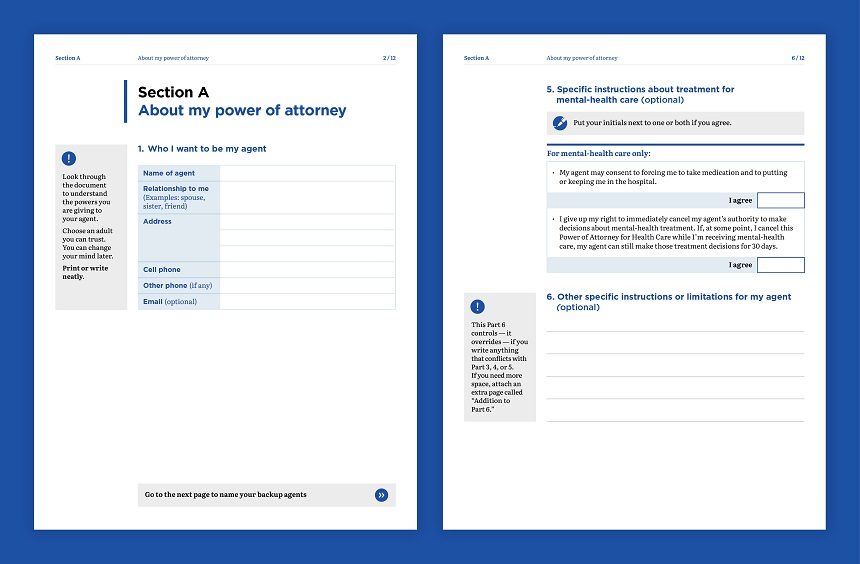
Clear design is critical to ensure the form accurately captures the user’s wishes. Image by Gusto Design
All boxes ticked
With its plain language and simple design, the Power of Attorney for My Health Care goes to the top of its class. It meets all the elements of the WriteMark® Plain Language Standard — and it’s the first document of its type to achieve the Standard.
Joseph Kimble, Distinguished Professor Emeritus at WMU–Cooley Law School, acknowledges the input from the WriteMark® team:
I’m grateful for the invaluable suggestions we received from Anne-Marie Chisnall (a member of our international board of advisers) and then from the WriteMark® assessment team. Those suggestions significantly improved almost every page.
And tested with users too
Since we originally published this story, researchers at Michigan State University have user-tested the Power of Attorney document. The Kimble Center applied recommendations from the user-testing report and did a little rewording and redesigning of the document. With these changes, the Power of Attorney achieved WriteMark® Plus.
WriteMark® Plus is awarded to documents that have reached the WriteMark® Standard and that also undergo user-testing for further fine-tuning.
Find out more about WriteMark® Plus — the ultimate in communication excellence
Legal documents unlike anything that the public has seen before
The Kimble Center for Legal Drafting paves the way for innovative legal documents. This article on the Center’s website describes its origins and goals.
Anne-Marie Chisnall July 31st, 2020
Posted In: The WriteMark, WriteMark Holders, WriteMark Plus
Tags: accessibility, Joseph Kimble, Kimble Center for Legal Drafting, Legal documents, plain language, the WriteMark, WriteMark Plus
Help! My appurtenance is on fire!

Avoid adding fuel to the fire with complicated communication. Image by Little Visuals. Pexels license.
When something catastrophic happens at home, you need to act fast. Can you imagine trying to get help like this?
“I need to undertake a disclosure with you. I’ll give you the full particulars. A bodily injury has occurred directly or indirectly. And I’m worried about the remediation. Can I priority request you and your apparatus be utilised to assist with the contamination damage?”
These convoluted phrases pepper real insurance documents. But when people need to understand what’s covered and how to make a claim, they need clear, accurate information that’s easy to navigate.
We’re thrilled that more insurance companies are taking this seriously.
Some companies are working hard on their legalese, rewriting dense, internally focused policies, forms, and letters so they are easy to read, easy to understand, and written for the reader rather than the writer.
And each year a few more make the WriteMark® grade.
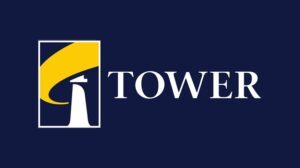
Congratulations to Tower for achieving the Write Mark and becoming a plain language champion! Image by Tower Insurance.
Tower Insurance is on a mission
Tower Insurance is one of the latest. Tower’s recent commercials proudly proclaim that they now have the WriteMark® on 14 home, contents, and vehicle policies. Their campaign dismantles difficult words and shows the difference straightforward language can make.
Words for work, or words for wonder?
Tower’s image of the word ‘appurtenance’ exploding symbolises their mission to simplify insurance.
And it had us scratching our heads.
Because, even though our WriteMark® assessors include authors, linguists, editors, teachers, and all-round word nerds, many of us didn’t know what ‘appurtenance’ meant.
These are people who send emails headed ‘Noun string of the day’, and can spend half an hour discussing the subtle difference between ‘moved home recently’ or ‘recently moved home’. They savour the richness, elegance, and (let’s be honest) perverseness of the English language.
We can all appreciate that ‘appurtenance’ is a lovely-sounding word with a fascinating etymology.
First known use of appurtenant
14th century
History and etymology for appurtenant
Middle English apertenant, from Anglo-French appurtenant, present participle of apurtenir to belong — more at ‘appertain’
History and etymology for appertain
Middle English apperteinen, from Anglo-French apurtenir, from Late Latin appertinēre, from Latin ad- + pertinēre to belong — more at ‘pertain’
But we’re also citizens and policy holders, who need to find our way through important information, often under stress. In times like these we want clarity, not a linguistic lift. We want information where writers have put the effort in to help us make decisions and take action.

There’s a time for tea and poetry and a time for getting the information you need. Image by Suzy Hazelwood. Pexels license.
Excellence for effort and an effort for excellence
We know it’s not straightforward, and companies that have reached the WriteMark® Standard for some documents deserve recognition for their courage and commitment. And once one or two documents have met the Standard, it’s very easy to spot those that still need work.
Congratulations to Tower!
But what does ‘appurtenance’ mean?
In home insurance, an appurtenance is a piece of property associated with the main dwelling. For example, it includes the garden and trees, and other structures on the property such as garages, decks, and swimming pools. It also includes items that are in some way part of the house, such as air-conditioning units, furnaces, and septic systems.
— many of which could catch on fire!
Anne-Marie Chisnall October 29th, 2019
Posted In: The WriteMark, WriteMark Holders
Tags: clear language, clear thinking, clear writing, improved writing, industry standards, plain language, power of plain language, Quality writing, Tower Insurance, writing for the public